Volcanologist Uses Local
Mountain Range As Geological Laboratory
Brandon Browne’s research takes
him all over the world. His latest focus is Mammoth Mountain
which hasn't erupted in about 50,000 years.
December 1, 2005
By Laurie McLaughlin
As they hop-scotched their way across
Russia’s Kamchatka Peninsula via helicopter
en route to explore and study Kizimen volcano — last
active in 1928 —Brandon L. Browne’s team landed
to refuel near another volcano, Karymsky, which had periodically
erupted since 1996 and is located about 80 miles south of
Kizimen.
“We desperately needed fuel, so the pilots
decided to make a quick stop. Soon after we landed, however,
we all heard an explosion. I looked up and saw an eruption
of ash and debris from the summit. We all were amazed and
petrified at the same time,” says Browne, assistant
professor of geological
sciences, who joined the faculty this year. The July 2002
explosion he witnessed at Karymsky was the closest he’s
ever been to a volcano in the throes of an eruption.
Browne is a volcanologist, and every volcano
he experiences, long dormant or not, is of interest to him.
Even this one, which he admits — at one-quarter of a
mile away — was a little too close for comfort, was
a thrill. “It felt similar to the first few seconds
of an earthquake,” he says, “where every sensory
preceptor in your body is electrified, and you become acutely
aware of every little thing around you.”
There are only about 1,000 volcanologists worldwide,
and while mountains have been erupting since the beginning
of time, says Browne, “volcanology is a very young science.
A lot of people study volcanic rocks, but few people actually
study volcanoes from the perspective of trying to understand
how volcanic eruptions occur. Fortunately, the field of volcanology
is one of the most rapidly growing in the geosciences.”
Browne’s research focus is to understand
how ash, rock and other debris that erupts from volcanoes
are transported and deposited in the surrounding landscape.
“With this information, authorities are better able
to plan for hazards in the event of an eruption,” he
says. His research has taken him around the world to both
dormant and active volcanoes in the Pacific Northwest, Japan,
Russia, Mexico, South America and Alaska, where he earned
his doctorate at the University of Alaska, Fairbanks.
One can’t help but notice, however, that
Browne is now in Fullerton, and there are no volcanoes in
Orange County.
“The closest volcano that I’m working
on now is Mammoth Mountain, which hasn’t erupted in
about 50,000 years,” he says. Browne already has traveled
up to the mountains on the eastern slope of the Sierra Nevada
range this semester with a group of CSUF students.
“First, we plan to look at how volcanic
eruptions at Mammoth were triggered, and second, we plan to
determine the time span between the triggering event —
which typically occurs deep in the crust — and the eruption
of magma at the surface,” he says. “For most volcanoes,
this time span ranges from a few days to many months. Data
from our research will allow local authorities in Mammoth
Lakes to know how much time they have before an eruption is
likely to occur in the future.”
No two volcanoes behave in exactly the same
way, adds Browne. “They are like people. Each one is
different, and you have to figure out their personalities
to know what they’ll do.”
«
back to News Front
|
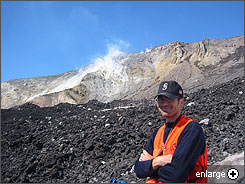
Gareloi Volcano on the Aleutian Islands, Alaska,
blows some steam during a visit to the site by
Brandon Browne, assistant professor of geological
sciences at Cal State Fullerton.
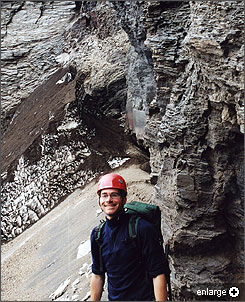
Brandon Browne explores volcanic sites at Aniakchak
National Park, Alaska.(2/6)
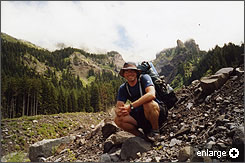
Volcanologist Brandon Browne hikes his way towards
Mount Hood, a volcano located near Portland, Oregon.
The Cal State Fullerton faculty member is among only
about 1,000 volcanologists worldwide. “Fortunately,”
he says, “the field is one of the most rapidly
growing in the geosciences.” (3/6)
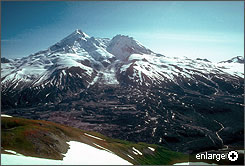
Redoubt Volcano, Alaska — one of the volcanic
sites that Brandon Browne has visited as part of his
study into how debris is transported and deposited
in the surrounding landscape. (4/6)
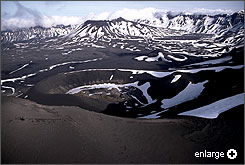
Aniakchak Volcano on the Alaskan Peninsula. As one
of only about 1,000 volcanologists worldwide, Brandon
Browne studies volcanoes to understand how eruptions
occur. (5/6)
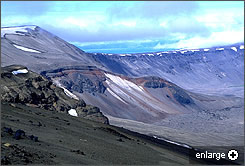
A view of volcanic slopes in Aniakchak National Park,
Alaska. Brown studies volcanos to understand how ash,
rock and other debris that erupts from volcanoes are
transported and deposited in the surrounding landscape.
(6/6)
|
| Get Expert Opinions On... |
|
 |
|
|